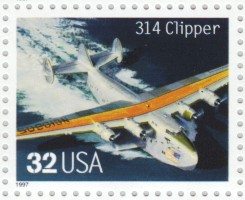Seaplanes
Today, we ask what ever became of flying boats. The University of Houston's College of Engineering presents this series about the machines that make our civilization run, and the people whose ingenuity created them.
The problem of finding clear space for takeoffs and landings dogged the first would-be airplane inventors. Several people tried to use water instead of land, even before the Wright brothers. And the Wrights took off from a pair of rails. The first person who actually flew off water was Henri Fabre. In 1910, he flew his flimsy seaplane for a mile and a half in a harbor near Marseilles.
Three years later, the first commercial flying service was begun with an early French seaplane. Twice a day it made the twenty-mile flight between Tampa and St. Petersburg in Florida. It could carry only one passenger, and the cost of the trip was five dollars.
Twenty years later, commercial flying boats were the largest things in the sky. It felt safe to cross water in a flying boat, and that's how they were used. Pan American began service down to Central America with a ten-passenger Sikorsky S-38 seaplane in 1928. By 1934 it was replaced with big flying boats like the Martin M-130 which could carry forty people three thousand miles.
Grandest of the successful flying boats was the Boeing 314, nicknamed the Yankee Clipper. Pan American used it between 1941 and '46. It had almost the wingspan of a 747 and could carry seventy people over four thousand miles.
Several truly enormous flying boats were built after the Yankee Clipper, but they came at the wrong time. Biggest of all was the Hughes Hercules -- better known as the "Spruce Goose." Its wingspan was half again that of a 747, and it stood eighty feet high. It was meant to carry seven hundred people. In 1947 Howard Hughes flew it thirty feet into the air over Los Angeles harbor. Then he put it away, and it's been maintained, unused, ever since, in mute and perplexing testimony to Hughes' convoluted thinking.
But Howard Hughes was nothing if not brilliant. He probably just saw what was coming. When big propeller-driven airliners, and then jets, came into service after WW-II, seaplanes lost their advantage. The land-based planes could now fly the ocean. There was no longer anything to be gained by using one kind of airplane over water and another over land. Furthermore, seaplanes were inherently large-bodied, high-winged machines -- not at all suited to near-sonic speeds. Still, their large bodies made them wonderfully spacious. The largest had three-story interiors, and they looked not unlike whales.
Small seaplanes can be found today in Canada and Alaska, where lakes are a lot easier to find than landing strips. But the big flying boats are gone. All my life I've wanted just once to fly in one, and now I don't know if any still exist. Only the last of these wonderful old behemoths remains. That's Howard Hughes' Spruce Goose, and it represents a bittersweet misreading of where the technology of flight was actually headed after WW-II.
I'm John Lienhard, at the University of Houston, where we're interested in the way inventive minds work.
(Theme music)
Angelucci, E., World Encyclopedia of Civil Aircraft. New York: Crown Publishers, Inc., 1982, Chapter 1.
Bilstein, R. E., Flight in America: From the Wrights to the Astronauts. Baltimore: The Johns Hopkins University Press, 1984.
For more on the present storage of the Spruce Goose see Episode 1722.
A surprising number of people responded to this program with reminiscences and additional information. John Marsh, for example, pointed to a new article featuring two surviving Martin Mars seaplanes, presently working as water carriers for fighting forest fires (Air & Space, Jan. 2001). Hunter Todd called to tell of flying during the early 1990s in a surviving Hawker Siddley flying boat, which was serving the Virgin Islands.
My special thanks to listener Thomas Tella who writes, "Please rejoice in knowing that at least four other [great flying boats] remain: a Sikorsky S39B Alaska and a Sikorsky VS44A Excambian, both at the New England Air Museum in Windsor Locks, Connecticut, and two Martin Mars, Phillipine Mars and Hawaii Mars both still in service as fire-fighters in Port Alberni, British Columbia."
It is clear that I am not alone in looking back upon those huge aeroplanes with great fondness.
This is a revised version of Episode 114.

The Pan American Clipper

Howard Hugh's Spruce Goose at the apogee of its only flight